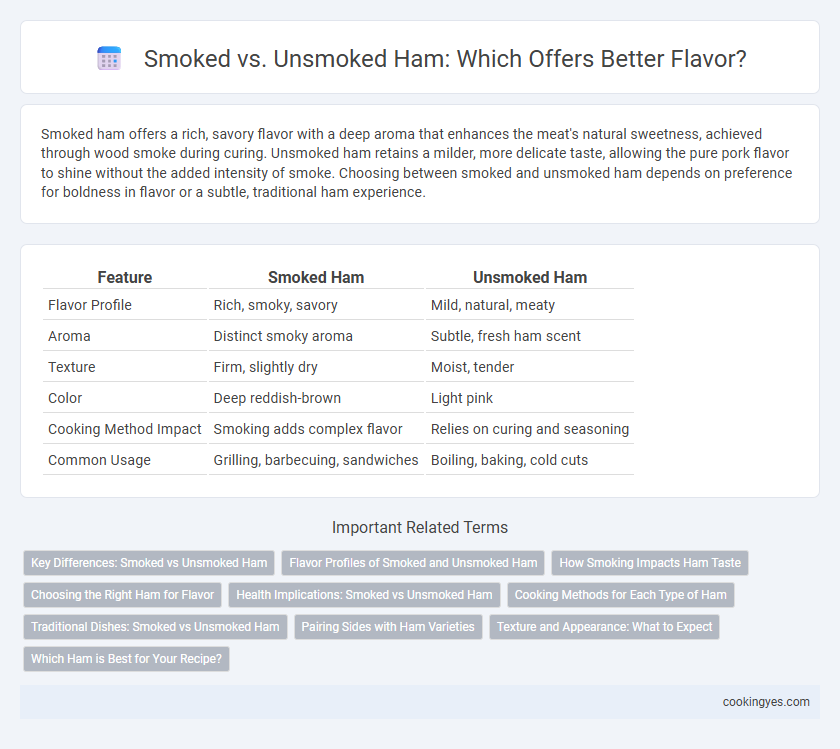Smoked ham offers a rich, savory flavor with a deep aroma that enhances the meat's natural sweetness, achieved through wood smoke during curing. Unsmoked ham retains a milder, more delicate taste, allowing the pure pork flavor to shine without the added intensity of smoke. Choosing between smoked and unsmoked ham depends on preference for boldness in flavor or a subtle, traditional ham experience.
Table of Comparison
| Feature | Smoked Ham | Unsmoked Ham |
|---|---|---|
| Flavor Profile | Rich, smoky, savory | Mild, natural, meaty |
| Aroma | Distinct smoky aroma | Subtle, fresh ham scent |
| Texture | Firm, slightly dry | Moist, tender |
| Color | Deep reddish-brown | Light pink |
| Cooking Method Impact | Smoking adds complex flavor | Relies on curing and seasoning |
| Common Usage | Grilling, barbecuing, sandwiches | Boiling, baking, cold cuts |
Key Differences: Smoked vs Unsmoked Ham
Smoked ham is characterized by its rich, smoky flavor and darker color, resulting from exposure to wood smoke during the curing process, while unsmoked ham offers a cleaner, milder taste with a softer texture. The smoking process imparts compounds like phenols and aldehydes that enhance the ham's aroma and shelf life, contrasting with the straightforward salt-cured profile of unsmoked ham. Key differences also include the complexity of flavor in smoked ham versus the subtle, natural pork essence preserved in unsmoked varieties.
Flavor Profiles of Smoked and Unsmoked Ham
Smoked ham features a rich, deep flavor with notes of wood, spice, and subtle sweetness imparted by the smoking process, enhancing its savory and slightly salty profile. Unsmoked ham offers a more delicate, natural pork taste with a mild saltiness and a tender texture, allowing the pure meat flavors to dominate. The difference in flavor profiles makes smoked ham ideal for bolder dishes, while unsmoked ham suits recipes that highlight the freshness and softness of the meat.
How Smoking Impacts Ham Taste
Smoking ham infuses it with complex smoky, woody, and slightly sweet flavors, enhancing its overall taste profile compared to unsmoked varieties. The smoking process caramelizes the surface, creating a rich umami depth and a subtle crispness that balances the saltiness of the cured meat. Unsmoked hams retain a cleaner, milder flavor, relying more on the curing process for taste without the robust aroma and character imparted by smoke.
Choosing the Right Ham for Flavor
Smoked ham delivers a rich, smoky flavor profile derived from the curing wood, enhancing depth and complexity in dishes. Unsmoked ham offers a cleaner, milder taste that highlights the natural sweetness of the pork, ideal for recipes requiring subtle seasoning. Selecting between smoked and unsmoked ham depends on the desired intensity and flavor balance, with smoked varieties favored for robust, savory meals and unsmoked preferred for delicate or sweet preparations.
Health Implications: Smoked vs Unsmoked Ham
Smoked ham contains compounds such as polycyclic aromatic hydrocarbons (PAHs) and nitrosamines, which may increase the risk of certain cancers when consumed in large quantities. Unsmoked ham typically has lower levels of these potentially harmful substances, making it a healthier option for regular consumption. Choosing unsmoked ham reduces exposure to chemical byproducts formed during the smoking process, contributing to better long-term health outcomes.
Cooking Methods for Each Type of Ham
Smoked ham develops deeper, richer flavors through smoking techniques such as cold smoking or hot smoking, which infuse the meat with smoky compounds while also partially cooking it. Unsmoked ham relies primarily on curing methods like brining or dry curing, with cooking methods including baking, boiling, or roasting to fully develop its tender texture and natural taste. Understanding these distinct processes helps optimize flavor profiles and ensures proper preparation tailored to either smoked or unsmoked ham varieties.
Traditional Dishes: Smoked vs Unsmoked Ham
Smoked ham delivers a rich, robust flavor profile with deep, woody undertones ideal for traditional dishes like Southern smoked ham with collard greens or German Eisbein. Unsmoked ham offers a milder, more delicate taste that enhances the subtle flavors in recipes such as Italian prosciutto or French jambon de Paris. The choice between smoked and unsmoked ham impacts the overall dish, influencing both flavor intensity and cooking methods in classic culinary traditions.
Pairing Sides with Ham Varieties
Smoked ham delivers a rich, smoky flavor that pairs excellently with sweet sides like baked apples, maple-glazed carrots, and candied yams, enhancing its savory depth. Unsmoked ham offers a milder, saltier taste that complements creamy mashed potatoes, green beans almondine, and mustard-based potato salad, highlighting its delicate texture. Selecting sides that balance or accentuate these flavor profiles creates a harmonious meal experience tailored to each ham variety.
Texture and Appearance: What to Expect
Smoked ham features a rich, deep color with a slightly glossy exterior and a firm yet tender texture resulting from the smoking process, which also imparts a distinctive smoky aroma. Unsmoked ham typically has a pale pink to light beige hue, a moist surface, and a smoother, more delicate texture that highlights its natural pork flavor. Both variations offer unique visual and textural traits, with smoked ham displaying a more robust appearance and firmer bite, while unsmoked ham presents a softer feel and lighter color profile.
Which Ham is Best for Your Recipe?
Smoked ham delivers a rich, smoky flavor that enhances BBQ dishes and adds depth to sandwiches, ideal for recipes requiring a pronounced taste. Unsmoked ham offers a milder, sweeter profile, making it suitable for dishes where the natural pork flavor should stand out, such as in salads or baked casseroles. Choosing between smoked and unsmoked ham depends on the desired intensity of flavor and the specific culinary application within your recipe.
Smoked vs Unsmoked for Ham Flavoring Infographic

 cookingyes.com
cookingyes.com